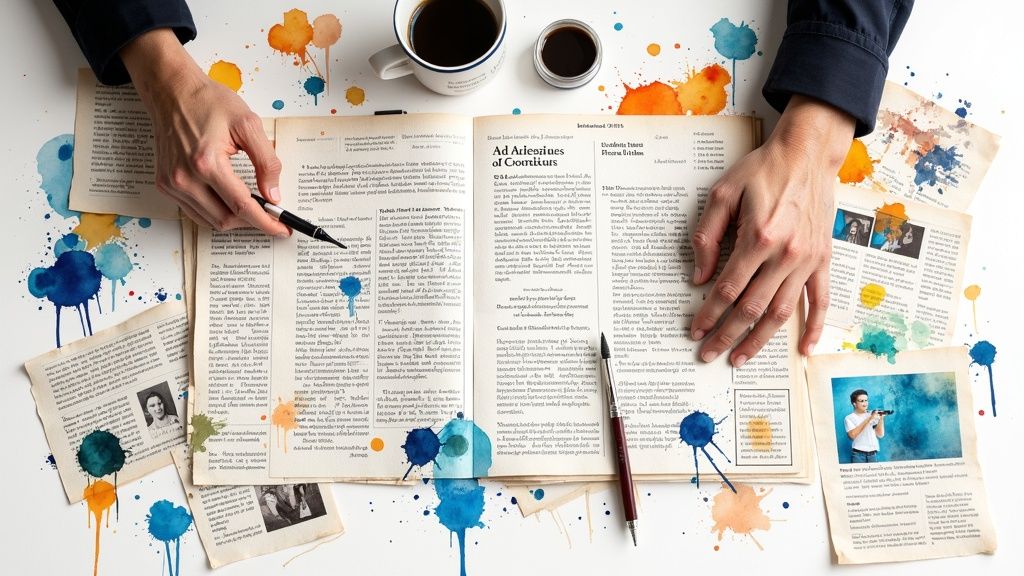Understanding What Makes Press Notes Work Now

Getting a press note to stand out requires more than just blasting it out to media contacts. With countless press releases competing for attention every day, successful press notes need to genuinely connect with journalists and readers. Think about the last headline that made you stop scrolling - it probably sparked your curiosity rather than just stating facts. This same principle applies to writing press notes that get noticed and picked up by media.
Going Beyond the Basics: The Anatomy of a Successful Press Note
A great press note combines authentic storytelling with concrete data in a way that feels timely and relevant. Simply announcing a new product rarely grabs attention anymore. Instead, focus on showing why your news matters to real people. For instance, when announcing a software update, don't just list technical specs - explain how it solves an actual problem that users face. Back up your message with specific numbers and metrics that demonstrate impact, like user adoption rates or market research findings. This combination of human interest and hard data makes your press note both relatable and credible.
The Power of a Compelling Narrative in Press Notes Examples
Media outlets want stories that their readers will care about and remember. That's why framing your press note as a compelling narrative can dramatically increase its chances of getting coverage. Consider who benefits from your news, what problem it solves, and why timing matters right now. Rather than rattling off features, weave them naturally into a story about real impact. For example, instead of just describing a new healthcare app's functions, tell the story of how it helps busy parents get care for their kids more easily. This human-centered approach transforms dry announcements into stories worth sharing.
Showcasing Value and Relevance Through Strong Press Notes Examples
With so many press notes competing for attention, showing clear value and relevance is essential. Connect your announcement to broader industry trends and current events that journalists are already covering. If you're in tech, for example, show how your news fits into important conversations about privacy or accessibility. This positions your press note as part of the bigger picture rather than just another product launch. You might be interested in: How to create engaging content. By making these connections thoughtfully, you demonstrate why your news deserves coverage right now. The next crucial step is crafting headlines that capture attention and make readers want to learn more.
Crafting Headlines That Actually Get Read
A compelling headline makes or breaks your press note - it's your only chance to grab attention in a crowded media landscape. If your headline falls flat, even the most important announcement risks being ignored. Great headlines do more than summarize facts - they intrigue readers and compel them to learn more, all while avoiding clickbait tactics.
The Art of the Irresistible Headline: Press Notes Examples
Looking at successful press notes reveals clear patterns in headlines that consistently perform well. Numbers and statistics are especially effective at catching the eye. For instance, "Survey Reveals 70% of Consumers Prefer Eco-Friendly Packaging" immediately communicates value through concrete data. Research shows that numerical figures naturally stand out when readers scan text, making this approach particularly powerful.
Another winning strategy is to pose questions that directly address reader concerns. Headlines like "Is Your Business Prepared for the New Data Privacy Regulations?" create immediate engagement by highlighting a potential problem while promising answers within the press note.

Balancing Newsworthiness and SEO Value
While your primary goal is capturing attention, headlines also need to work well for search engines. This means thoughtfully incorporating relevant keywords like "press notes examples" while keeping the text natural and engaging. Instead of a basic "New Product Launch" headline, try something like "Innovative [Product Category] Product Launches, Setting New Standards in [Industry]." This approach serves both human readers and search algorithms by highlighting unique value while maintaining clear keyword relevance.
Headline Templates for Success
To help streamline your headline writing process, here are some proven templates you can adapt:
- Announcement: "[Company] Announces [Newsworthy Action] to [Benefit/Impact]"
- Intrigue: "The Secret to [Desired Outcome] Revealed by [Company/Expert]"
- Data-Driven: "[Statistic]% of [Target Audience] Experience [Problem/Trend]"
These frameworks give you a solid starting point - simply customize them to fit your specific news angle and industry context. The right headline opens doors to media coverage and helps your press note reach the audience it deserves.
Making Your Press Notes Visual and Engaging
In a world where visuals drive engagement, adding multimedia elements to press notes can dramatically increase their impact and pickup rates. By thoughtfully incorporating images, videos, and interactive content, you can transform a basic announcement into a compelling story that captures attention and drives results.
Selecting the Right Visuals for Your Press Notes Examples
When choosing visuals, start by considering how they support your core message. If you're announcing a new mobile app, clear screenshots highlighting key features instantly demonstrate its value to readers. For partnership announcements, photos showing representatives from both organizations add credibility and a human element. The key is choosing visuals that strengthen your narrative without overwhelming it - too many irrelevant images can distract from your main points and dilute your message's impact.
Incorporating Video and Interactive Elements
Videos are particularly effective at bringing press note content to life. A brief product demo or customer testimonial helps readers quickly grasp complex concepts and builds excitement around your announcement. You might find this guide helpful: How to do a video voice-over. Adding interactive elements like polls or quizzes can also boost engagement, but make sure they feel natural and add real value rather than appearing forced or gimmicky.

Balancing Professionalism and Authenticity
While maintaining professional quality is essential, authenticity matters just as much. Your visuals should align with brand guidelines while still feeling genuine and relatable. Behind-the-scenes photos or videos showing your team at work can create stronger connections with readers than overly staged corporate shots. Finding this sweet spot between polished and authentic helps your press notes resonate with both journalists and their audiences.
Formatting and Distribution Across Platforms
Consider how your visuals will perform across different channels and devices. Optimize image sizes for fast loading without sacrificing quality. Include alt text for accessibility and SEO benefits. Test video playback across major platforms and devices. Taking time to address these technical details helps ensure your visually rich press notes deliver maximum impact while providing a smooth experience for all readers. With careful planning and execution, multimedia elements can transform basic announcements into engaging stories that truly capture attention.
Timing Your Release For Maximum Impact
Smart press release timing involves more than just picking a good day - it requires carefully matching your announcement with your audience's habits, industry events, and news cycles. When you get the timing right, you can dramatically increase how many people see and engage with your message.

Identifying Optimal Release Windows
To reach your target audience effectively, you need to understand their daily routines and preferences. For instance, if you're targeting business professionals, sending your press release early on a weekday morning catches them as they review industry news over their morning coffee. The timing also matters for industry events - launching a new tech product during a major conference naturally attracts more attention than releasing it during a quiet period. Looking at how your past press releases performed can reveal helpful patterns for future timing decisions.
Leveraging News Cycles and Industry Events
Pay close attention to what's happening in your industry and the broader news cycle. When you can connect your announcement to current conversations and trends, journalists are more likely to pick up your story. For example, if you're announcing an eco-friendly initiative, timing it around Earth Day or an environmental conference makes perfect sense. This kind of thoughtful timing helps your news feel relevant and worth covering.
Managing Embargoes and Stakeholder Coordination
For bigger announcements involving multiple partners, embargoes can be very helpful. An embargo lets you give journalists early access to your news while controlling exactly when they can publish it. This gives them time to write thorough stories and helps ensure multiple outlets cover your news simultaneously when it goes live. Just make sure you communicate clearly with everyone involved about the embargo terms and timing.
Adapting Your Timing Strategy Based on Data
Watch how your press releases perform and use that data to improve your timing. Track metrics like engagement, website traffic, and media pickups at different times and on different platforms. If you notice your releases consistently get more attention on Tuesdays, for example, adjust your schedule accordingly. Keep analyzing results and fine-tuning your approach based on what actually works. Create a flexible distribution calendar that you can adjust as you learn more about what resonates with your audience and as news cycles shift.
Measuring What Actually Matters
The real work in PR begins after sending a press release. Success comes from understanding its true impact, not just counting basic pickup numbers. We need to look beyond surface-level metrics to measure what genuinely demonstrates the effectiveness of your press notes. Let's explore how to track meaningful data and use those insights to make your PR strategy stronger.
Defining Key Performance Indicators (KPIs) for Press Notes
The first step is getting clear on what success means for your specific press notes. Different goals require different measurements - if you want to build brand awareness, you'll focus on social media mentions and share of voice. But if your goal is driving sales, you'll need to track metrics like product page clicks and conversion rates. By choosing the right KPIs upfront, you can properly gauge whether your press notes are hitting their targets.
Tracking Immediate Impact vs. Long-Term Value
While it's important to measure the quick wins like website traffic spikes and social media buzz in the first 24 hours after release, the real value often develops over time. A successful press note might cause an initial surge in site visits, but the lasting impact shows up in steadily improving search rankings weeks later. To get the full picture, track both short-term engagement metrics and long-term indicators like sustained traffic increases, growing backlinks, and ongoing brand mentions in relevant discussions.
Tools and Techniques for Data Collection
You'll need a mix of tools to gather useful data. Google Analytics shows you where traffic comes from and how users behave on your site. Media monitoring platforms track coverage and online mentions to measure reach. Social listening tools help you understand how people talk about and engage with your content across social networks. Combine these with targeted surveys and feedback forms to build a complete view of how your press notes perform.
Using Data to Continuously Improve Performance
The real power of measurement is using it to make each press note better than the last. By analyzing what content resonates most, which distribution channels work best, and where you can improve, you can keep refining your approach. For example, if a press note gets lots of social shares but few website visits, you might add clearer calls-to-action and direct links next time. This ongoing cycle of measuring results, learning from the data, and adjusting your strategy helps you steadily increase the impact of your press notes over time.
Leveraging AI While Staying Human
As press release distribution continues to evolve, artificial intelligence (AI) has emerged as a powerful tool to enhance how we create and share news. But the key is finding the right balance - using AI strategically while preserving the human elements that make press releases compelling and authentic.
Identifying AI Tools That Deliver Real Value
With countless AI tools on the market, it's important to focus on solutions that address specific needs in your workflow. AI writing assistants can help generate initial drafts and suggest headline alternatives, giving human writers more time to refine messaging and develop stronger narratives. AI-powered distribution platforms can also help target the right journalists and personalize outreach for better coverage. Think of AI as your capable assistant handling routine tasks while you focus on strategy and creative direction.
Real-World Examples of AI-Driven PR Success
Many organizations are already seeing results from thoughtfully incorporating AI into their press release process. Some use AI analytics to spot trending topics and shape their messaging accordingly, helping ensure press notes connect with current conversations. Others leverage AI to match press releases with journalists most likely to be interested, based on their previous coverage patterns. This targeted approach often leads to higher pickup rates and more effective campaigns.
Maintaining Authenticity in the Age of AI
While AI brings powerful capabilities, the human touch remains essential for building trust and connecting with audiences. Press releases created solely by AI often lack the nuance, personality and emotional resonance that skilled writers provide. Consider AI a tool to enhance your work rather than replace human creativity. Use it to gather data insights and improve workflows, but always have experienced writers review and refine the output to maintain your brand voice. This combination of AI efficiency and human oversight leads to press releases that are both data-informed and genuinely engaging. You might be interested in: How AI is transforming video quality.
Practical Guidelines for Integrating AI
Begin by identifying specific areas where AI could improve your PR process, whether that's generating headline options or optimizing distribution lists. Research AI tools that fit your needs and budget, then start with a small pilot project to test effectiveness before wider implementation. Regularly assess results and gather team feedback to ensure the AI tools deliver value while preserving essential human elements. This measured approach helps you make the most of AI's capabilities responsibly.
Ready to transform your video content creation process? Aeon, our innovative video creation platform, empowers publishers to effortlessly create engaging videos from text, video, or audio. Learn more and request a demo at https://www.project-aeon.com.